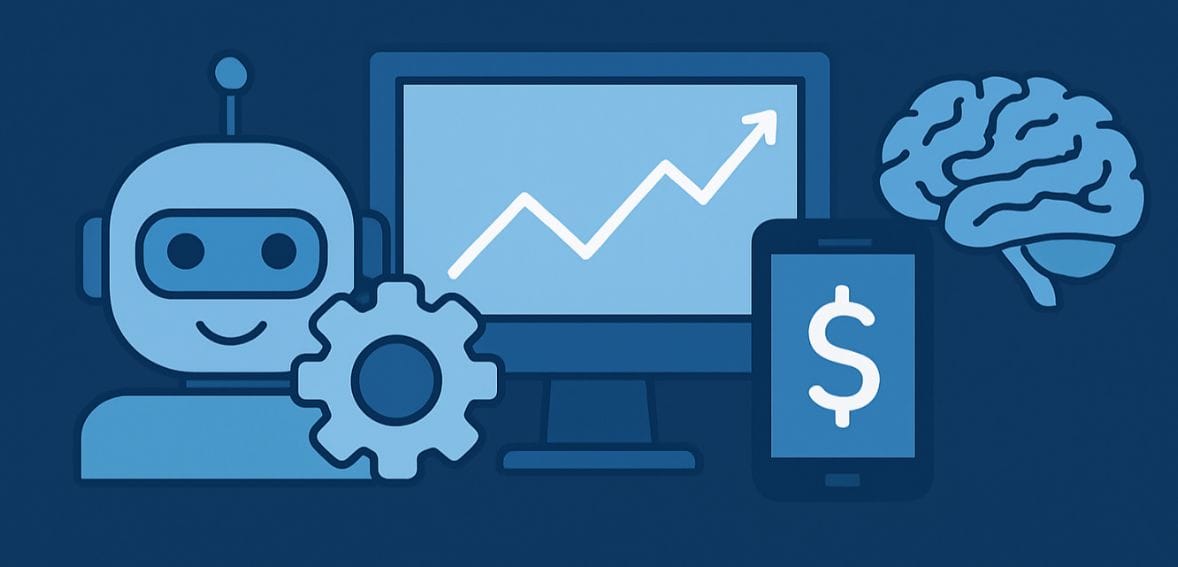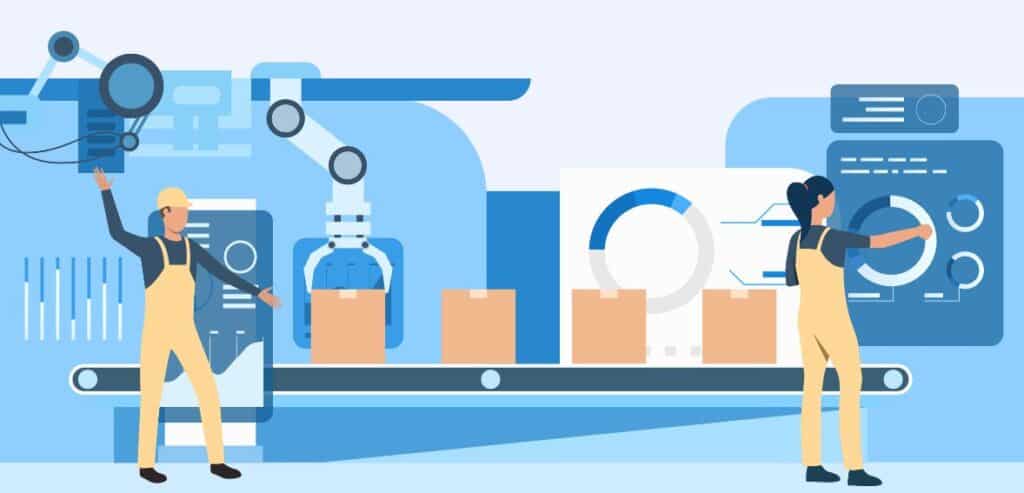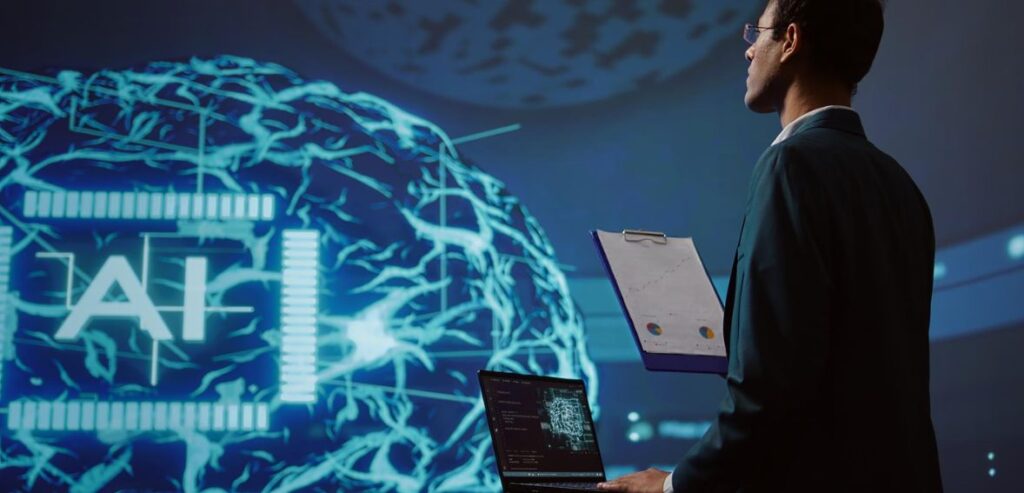
By Bethany Johnson August 20, 2025
AI and Automation in Merchant Services are no longer futuristic concepts—they are transforming the way businesses handle payments today. These technologies are reshaping merchant services, from fraud prevention to customer experience, by providing merchants with tools that boost productivity, security, and profitability. In a rapidly evolving digital economy, business owners must understand how AI and automation are impacting payment systems to stay competitive.
It is now imperative for business owners to understand how automation and artificial intelligence are impacting payment systems to remain competitive in a digital economy. AI is emerging as a reliable partner in day-to-day operations, whether it is used to automate reconciliation tasks, forecast transaction risks, or customize checkout experiences.
Merchants are faced with both new opportunities and challenges as this transformation gains momentum. Processing payments in the future will involve more than just speed and convenience; it will involve creating technologically driven, intelligent, and human-centered systems.
The Rise of AI and Automation in Payments

The way companies receive, process, and handle payments is changing at a never-before-seen rate in today’s dynamic business environment. Automation and artificial intelligence (AI) together are rapidly becoming a necessary component of standard merchant services, no longer a sci-fi idea exclusive to tech behemoths. This change creates both excitement and uncertainty for entrepreneurs.
On the other hand, AI promises cost savings, efficiency, and more intelligent customer experiences. However, it also raises questions about trust, complexity, and whether smaller players can adapt to the quick changes affecting digital payments.
As we move forward, it becomes evident that automation and artificial intelligence are more than just fads; they are forces that will fundamentally alter how consumers pay, how businesses function, and how financial systems develop.
Beyond Fraud Detection: Smarter Payment Processing
Once its most popular use, fraud detection is now just one aspect of AI’s role in merchant services. These days, machine learning models are being used to predict consumer preferences, customize checkout processes, and expedite back-end operations.
AI-driven systems examine patterns across millions of transactions in real time, adjusting continuously as fraud strategies change, rather than depending only on predetermined rules to flag suspicious transactions.
This lowers the friction of false declines that annoy real customers ,in addition to improving the security of payment processing. A more seamless and secure checkout process fosters trust, and trust is crucial in a time when consumer loyalty is fragile.
Automation as the Engine of Efficiency
The operational aspect of merchant services is changing due to automation. Automated workflows are streamlining many of the manual processes that used to take up staff time, like chargeback responses, compliance reporting, and reconciliations. For small businesses, this means spending more time serving clients or growing the company rather than spending as much time mired in paperwork.
Automation increases productivity across business models, from simplifying chargeback responses to streamlining compliance reporting. Yet, when human intervention is required—especially under pressure—a quick merchant services support call can make all the difference in maintaining operational continuity.
The New Customer Experience
Another area that AI and automation are changing is the customer experience. Merchants are using intelligent systems to meet the growing demands of consumers for speed, convenience, and personalization. For example, chatbots driven by AI are developing into virtual assistants that can help clients with payment disputes, respond to inquiries regarding charges, or even suggest payment methods based on historical usage.
Behind the scenes, automation makes sure that these procedures are completed immediately, cutting down on wait times and raising customer satisfaction. Consumers may not always be aware of AI’s assistance, but they will notice when a business streamlines it’s payment process.
Predictive Analytics and Business Foresight

Predictive analytics driven by AI is expected to become even more significant in the future. Imagine if a retailer could predict payment risks in addition to sales trends before they materialize. To assist businesses in making more informed financial decisions, artificial intelligence (AI) models can examine consumer behavior, seasonal trends, and outside variables like changes in the economy.
For example, an online retailer could take proactive steps ahead of time to prepare for an anticipated spike in chargebacks following a holiday season. In increasingly volatile markets, this kind of foresight gives merchants a competitive advantage.
Stronger Security Without Added Friction
Payment processing still revolves around security, which is where AI will have the biggest impact. Although fraudsters are always coming up with new ways to take advantage of systems, automation and artificial intelligence are leveling the playing field. In order to instantly verify transactions, sophisticated algorithms can already analyze device histories, biometric data, and even geolocation signals.
Compared to conventional password or PIN methods, these tools enable merchants to authenticate payments with significantly higher accuracy. Automation makes sure that these security checks are carried out covertly so that complicated procedures don’t slow down the customer experience. AI-driven solutions are making it easier than ever to strike a delicate balance between seamless convenience and robust security.
Challenges of Accessibility and Inclusion
Businesses cannot overlook the challenges that come with all of these advancements. Accessibility is among the most important. Smaller retailers frequently face financial obstacles and a lack of technical know-how, whereas large corporations may readily adopt state-of-the-art AI and automation tools. This begs the question: Will artificial intelligence increase the disparity between large and small companies in the payments industry?
Innovative companies are starting to solve this by providing small and mid-sized enterprises with scalable, reasonably priced AI-powered solutions. In order to prevent innovation from displacing the very companies that are the foundation of economies, the future of merchant services must be inclusive.
The Transparency Problem in AI Systems

Transparency presents another difficulty. Both customers and merchants may be hesitant to trust “black box” systems as AI assumes greater decision-making responsibilities. Both the company and the customer will want to know why a payment was refused.
The need for explainable AI is increasing, and service providers will have to balance the need for strong algorithms with the need for clear communication. Trust is based on accountability as much as performance, and the businesses that put accountability first will be at the forefront of merchant services in the future.
Balancing Automation and the Human Element
Concerns regarding the human component of payments are also raised by automation. Even though AI can process data incredibly quickly, human judgment and empathy are still invaluable in some business situations. For example, a consumer contesting a charge might value the system’s ability to evaluate the situation immediately, but they might also desire the assurance of interacting with a live person.
The most successful future systems will probably blend the speed of automation with the friendliness of human assistance, guaranteeing that merchants provide not only efficiency but also sincere connections.
Regulation and Compliance in the Age of AI

Another area where AI and automation in merchant services will continue to be examined is regulation. The extent to which algorithms impact financial systems is becoming increasingly apparent to governments and financial authorities. This entails more oversight, more stringent compliance requirements, and the potential for international standards to influence the use of AI in payments.
It will be necessary for merchants to stay up to date with both changing regulations and technological advancements to maintain compliance. Here, suppliers of automated compliance solutions could be extremely helpful in assisting companies in staying within the law without imposing needless burdens.
AI and the Future of Pricing Models
In addition to risk management and compliance, AI is poised to revolutionize pricing models in merchant services. Traditionally, businesses have struggled with complex and often opaque fee structures.
AI-driven platforms can analyze transaction histories and recommend more cost-effective pricing models tailored to each merchant’s unique needs. This level of personalization could make pricing fairer, more transparent, and ultimately more beneficial for merchants who have long felt at the mercy of rigid service agreements.
Driving the Cashless Economy Forward
The transition to cashless economies will also be accelerated by the incorporation of automation and artificial intelligence into merchant services. Customers and businesses will increasingly choose digital payments over traditional ones as they become quicker, safer, and more intelligent. This includes emerging payment processing trends in EBT, which reflect how digital benefits systems are evolving to integrate seamlessly with modern payment infrastructures.
The whole payment ecosystem is becoming more fluid, from contactless payments in physical stores to easy one-click online checkouts. While merchants who oppose these changes risk falling behind, those who welcome them will be well-positioned to prosper.
A Global Perspective on Innovation

Recognizing the global scope of these changes is also crucial. In addition to influencing developed markets, AI and automation in merchant services are opening up new opportunities in areas with historically low levels of financial inclusion.
AI-enhanced mobile payment systems are opening up commerce to unbanked populations, filling gaps that traditional banking has found difficult to fill. This means a new customer base and easier cross-border scaling for global retailers.
Preparing for the Future of Merchant Services
Like any significant technological change, how companies choose to adjust will determine how AI and automation in merchant services develop in the future. In addition to increasing efficiency, those who carefully adopt the tools—balancing innovation and trust—will forge closer, more durable bonds with their clients.
Ignoring the changes puts businesses at risk of falling behind rivals who can provide more individualized, safer, and quicker experiences.
Humanizing the Role of AI
Ultimately, the story of AI and automation in merchant services is not just about technology. It is about the human desire for convenience, security, and connection in every transaction. It is about helping small businesses thrive, giving consumers confidence, and ensuring that commerce continues to evolve in ways that benefit everyone.
What comes next will not be determined by machines alone but by the choices merchants make in adopting, adapting, and humanizing these tools for the people they serve.
Conclusion: A Human Future Powered by AI
The increasing impact of automation and artificial intelligence is shaping the future of merchant services. These technologies are transforming how companies handle risks, secure payments, and provide customer service. Although speed, personalization, and efficiency are promised by the technology, merchants must strike a balance between automation, transparency, compliance, and the human touch that consumers still value.
To prosper in a cashless, data-driven economy, both small and large businesses must carefully adopt these innovations. Instead of replacing people with machines, the future will see intelligent systems improve how businesses interact with their clientele. Even though AI may power the procedures, human connection, relationships, and trust will always be at the core of business.